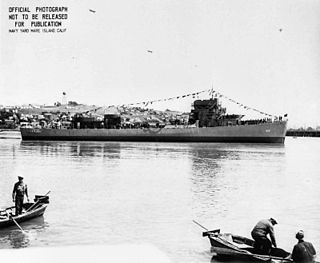
The third USS Farragut (DD-348) was named for Admiral David Glasgow Farragut (1801–1870). She was the lead ship of her class of destroyers in the United States Navy.

USS Dennis (DE-405) was a John C. Butler-class destroyer escort in the service with the United States Navy from 1944 to 1946. She was scrapped in 1973.

USS Devastator (AM-318) was an Auk-class minesweeper acquired by the U.S. Navy for the dangerous task of removing naval mines from minefields laid in the water to prevent ships from passing.

USS Capps (DD-550), a Fletcher-class destroyer, was a ship of the United States Navy named for Rear Admiral Washington L. Capps (1864–1935).

The first USS Dewey (DD-349) was a Farragut-class destroyer of the United States Navy, launched in 1934 and named for Admiral George Dewey. Dewey served in the Pacific through World War II. After escaping damage during the attack on Pearl Harbor, Dewey screened the aircraft carrier USS Lexington until the carrier was lost in the battle of the Coral Sea; then screened USS Saratoga through the invasion of Guadalcanal and the battle of the Eastern Solomons. Following overhaul in San Francisco, Dewey spent 1943 in Alaskan waters supporting the invasions of Attu and Kiska. Dewey spent 1944 supporting raids in the Marshalls, Carolines, and Marianas, including screening carriers during the battle of the Philippine Sea. After being damaged by Typhoon Cobra during the recapture of the Philippines, Dewey supported the invasion of Iwo Jima and spent the remainder of the war screening replenishment oilers.

USS Case (DD-370) was a Mahan-class destroyer in the United States Navy before and during World War II. She was the second ship named for Augustus Ludlow Case.

USS Downes (DD-375) was a Mahan-class destroyer in the United States Navy before and during World War II. She was the second ship named for John Downes, a US Navy officer.

USS Conner (DD-582) was a Fletcher-class destroyer of the United States Navy, the second Navy ship to be named in honor of Commodore David Conner (1792–1856), who led U.S. Naval forces during the first part of the Mexican–American War.

USS Fanning (DD-385) was a Mahan-class destroyer, in the United States Navy named for Nathaniel Fanning. Her first action was during World War II, immediately following the 7 December 1941 attack on Pearl Harbor. Fanning continued to serve in the Pacific Theatre throughout the war, and was decommissioned 14 December 1945. She was one of the last Mahan-class destroyers. Fanning and USS Dunlap were built from the same basic Mahan design but slightly modified. Some sources refer to them as the Dunlap-class destroyers.

USS Elden (DE-264) was an Evarts-class destroyer escort in the service of the United States Navy.
USS Motive (AM-102) was an Auk-class minesweeper built for the United States Navy during World War II. She earned three battle stars for World War II service. She was decommissioned in 1946 and placed in reserve where she remained until struck from the Naval Vessel Register in December 1966. She was sunk as a target in April 1968.
The third USS Champion (BAM-1/AM-314/MSF-314) was an Auk-class minesweeper of the United States Navy.

The second USS Fleming (DE-32), and first ship of the name to enter service, was an Evarts-class destroyer escort built for the United States Navy during World War II. While performing convoy and escort duty in the Pacific Ocean she was also able to sink one Japanese submarine and to shoot down several kamikaze planes that intended to crash onto her. For her military prowess under battle conditions, she was awarded four battle stars.

USS Sederstrom (DE-31) was a Evarts-class destroyer escort of the United States Navy during World War II. She was promptly sent to the Pacific Ocean to escort convoys and to protect other ships from Japanese planes and submarines. Her assignments took her from one battle area to another, but she was fortunate in remaining almost unscathed by the end of the war. For her efforts in battle areas, she was awarded five battle stars by war's end.

USS Emery (DE-28) was an Evarts-class destroyer escort constructed for the United States Navy during World War II. It was promptly sent off into the Pacific Ocean to protect convoys and other ships from Japanese submarines and fighter aircraft. By the end of the war, she had accumulated three battle stars.

USS Donaldson (DE-44) was an Evarts-class destroyer escort of the United States Navy during World War II. She was sent off into the Pacific Ocean to protect convoys and other ships from Japanese submarines and fighter aircraft. She performed escort and anti-submarine operations in dangerous battle areas and was awarded seven battle stars, a very high number for a ship of her type.

USS Lake (DE-301) was an Evarts-class destroyer escort of the United States Navy during World War II. She was sent off into the Pacific Ocean to protect convoys and other ships from Japanese submarines and fighter aircraft. She performed escort and antisubmarine operations in dangerous battle areas and returned home with two battle stars.

USS Finnegan (DE-307) was an Evarts-class destroyer escort constructed for the United States Navy during World War II. She was sent off into the Pacific Ocean to protect convoys and other ships from Japanese submarines and fighter aircraft. She performed escort and antisubmarine operations in dangerous battle areas and returned home with three well-earned battle stars.
USS Climax (AM-161) was an Admirable-class minesweeper built for the U.S. Navy during World War II. She was built to clear minefields in offshore waters, and served the Navy in the Pacific Ocean.
USS Counsel (AM-165) was an Admirable-class minesweeper built for the U.S. Navy during World War II. She was built to clear minefields in offshore waters, and served the Navy in the Pacific Ocean.
















